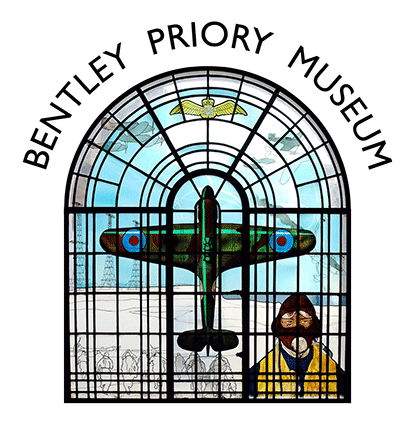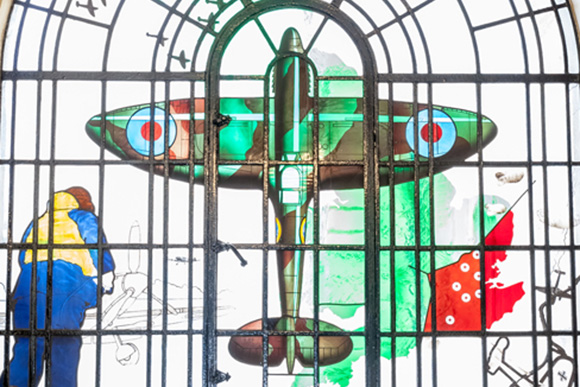Brian Nicholls, 1991
Dimensions: 300cm x 200cm
Material: Glass
To listen to the audio description of this object either click the object audio MP3 file below which will play it in your default audio player, or press the play button which you will find after the object audio MP3 file and this will play it from within the web page. The play button can also be used to pause the audio. This button is followed by the elapsed and remaining time, and a further button to mute the audio.
Spitfire Stained Glass Window Audio MP3 File
The large Spitfire stained-glass window was created to commemorate the 50th Anniversary of the Battle of Britain. It is situated on the left hand side of the Entrance Hall of Bentley Priory Museum, opposite a Hurricane stained glass window, thereby engaging Museum visitors immediately with Bentley Priory’s important Battle of Britain history.
The window is a rectangle, portrait in orientation, with a curved top. It is about two meters wide and almost three meters high at the tallest point. The black leading of the stained glass window panes follow the shape of the window, forming arches where the window curves at the top.
The Entrance Hall is quite dark, and so the natural light penetrating through the window makes the design more vivid.
In the centre, dominating the stained glass window, is an image of a Supermarine Spitfire aircraft, from a bird’s eye view. The Spitfire is emerald green interspersed with more subdued camouflage greens. A blue RAF roundel stands out in contrast on each wing. The Spitfire, known for its speed and agility, became the iconic aircraft of the Second World War, with over 20,000 produced.
In the lower left of the window is a pilot scrambling to his aircraft. He is running away from the viewer, wearing a vivid blue flying suit and bright yellow Mae West lifejacket. The propellers of his aircraft are visible in the distance. In the sky above him are silhouettes of Spitfires flying in formation. Behind the Spitfire in the centre is a map of Great Britain. The majority of Britain is coloured bright green, apart from the South-East of England, which has been sectioned off by a black line and is coloured red.
During the Battle of Britain, the country was divided into 4 administrative areas, known as Groups. The highlighted area in red represents Group 11, who were responsible for protecting the South East of England, including London. There are white dots indicating the locations of the sector stations, which controlled smaller regions within the group, and three barrage balloons. The outline of the French coastline appears in the lower right hand corner of the window and an enemy aircraft flies over it. At the top of the window sits the Royal Air Force ‘Pilot’s Wings’, in a bright yellow gold colour. The RAF’s initials are surrounded by a circular laurel wreath. An eagle’s wing extends from either side of the wreath and the monarch’s crown sits on top.
This window, along with the Hurricane window directly opposite, were commissioned in 1990 to commemorate the 50th Anniversary of the Battle of Britain, and were installed in 1991. Students from Chelsea College of Art and Design were invited to submit proposals for the windows. The designs by post-graduate student, Brian Nicholls, who had served in the RAF, were chosen. Also in the Entrance Hall are smaller windows commemorating other parts of the Dowding System and the Battle of Britain which were added later.
 What’s On
What’s On Opening Hours & Admission
Opening Hours & Admission

